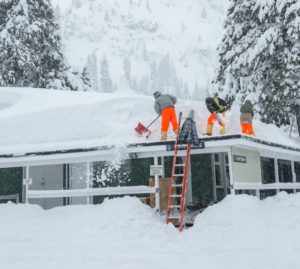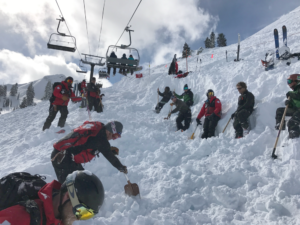The longest season in Squaw Valley history ended Saturday. Squaw Valley Alpine Meadows announced today that the Lake Tahoe ski resort is officially closed after offering skiing and riding for a record 200 days during the 2016-17 season.

Winter and summer blended together this season at Squaw Valley, resulting in an historic winter with operations until July 15, its latest closing ever. The 200 days of operations is nearly a month more than the average of 174 days.
“This season was one we will not soon forget,” said Andy Wirth, president and CEO of Squaw Valley Alpine Meadows. “Mother Nature dealt out her fair share of challenges, with snow totals, wind speeds and overall volatility of weather the likes of which have never been seen in the Sierra Nevada since ski areas have been in operation. However, the monumental snowpack brought the historic opportunity to operate well into summer.”
Squaw Valley accumulated 728 inches of snow – equaling more than 60 feet – the fifth highest total in North America. Ten Atmospheric River weather events hit the resort, where the average season sees two to four. January 2017 broke the resort’s record for most snow in one month with 282 inches, snowing 23 feet in 23 consecutive days. “Januburied” was followed by the snowiest February ever with another 196 inches.
“The spring skiing capital evolved into the summer skiing capital, and skiers and riders from across the country were enjoying the sun and snow right up to July 15,” Wirth said. “With unseasonably warm temperatures in the region, the snowpack has seen a rapid rate of melt, primarily in the key areas of lift loading and unloading zones. While teams have been working around the clock to maintain the snow surface, there is not sufficient snowpack for a safe, consistent slope, forcing the resort to conclude operations.”
Squaw was the only ski resort in the Lake Tahoe region to remain open in July. The resort, located in Truckee off Highway 89, initially closed during the week and extended weekend hours to 2 p.m. Two big bowl areas – Shirley Lake and Gold Coast – were open for Fourth of July weekend skiing and riding.
Although there is no longer skiing, the Aerial Tram at Squaw continues summer operations from 10:40 a.m. to 4:20 p.m., with the last download at 5 p.m. The operation continues daily through September 4, September 9-10 and September 16-17. The tram climbs over 2,000 feet from the base of Squaw Valley to High Camp, located at 8,200 feet, with 360-degree views of Lake Tahoe’s high alpine beauty.

Daily activities at High Camp include hiking trails, the Olympic Museum, dining, shopping, disc golf, lawn games, swimming and a spa located near an outdoor bar.
It was arguably the most prolific season for snow totals in Lake Tahoe history. As a result, ski resorts stayed open later this season than ever before.
Eight of the Top-10 season snow totals in North America were owned by Lake Tahoe ski resorts.
Sugar Bowl had the most snow among the Lake Tahoe resorts for the 2016-17 season, recording 795 inches. That put Sugar Bowl in second place among North American resorts, trailing only Mt. Baker in Washington, which had an astonishing 866 inches of snow.
Here’s a look at the Top-10 snow totals for North American resorts.
- Mt. Baker, Washington: 866 inches
- Sugar Bowl Resort, Lake Tahoe: 795 inches
- Mt. Rose Ski Tahoe, Nevada (near Lake Tahoe): 768 inches
- Boreal Mountain, Lake Tahoe: 751 inches
- Squaw Valley, Lake Tahoe: 728 inches
- Alpine Meadows, Lake Tahoe: 710 inches
- Northstar California, Lake Tahoe: 709 inches
- Kirkwood, Lake Tahoe: 702 inches
- Brighton, Utah: 674 inches
- Heavenly, Lake Tahoe: 659 inches